June 16, 2025 | 20:31 GMT +7
June 16, 2025 | 20:31 GMT +7
Hotline: 0913.378.918
June 16, 2025 | 20:31 GMT +7
Hotline: 0913.378.918

Famous painting of saola by artist Dao Van Hoang. Initially, scientists called this species Vu Quang Ox.
In 1992, vestiges of saola and giant muntjac were first discovered in Vu Quang National Park, Ha Tinh, and this shook the world. Scientists thought it was "almost impossible". It was at the time when people thought they had known all there was about large mammals. The science called saola by the name "Vu Quang ox" because it had a close family with the ox.
This ancient animal only exists in the wild mountains, between the border of Vietnam and Laos. Called it the "Asian unicorn", because the animal was so rare to be seen. Two ancient and rare elements make saola a pride in Vu Quang.
According to M.Sc. Nguyen Viet Hung, Head of Science, Technology & International Cooperation Department (Vu Quang National Park), the discovery of saola - the "Asian Unicorn" and the giant muntjac in the middle of the jungles in the 90s made the scientific world realize the incomparable value of this land.
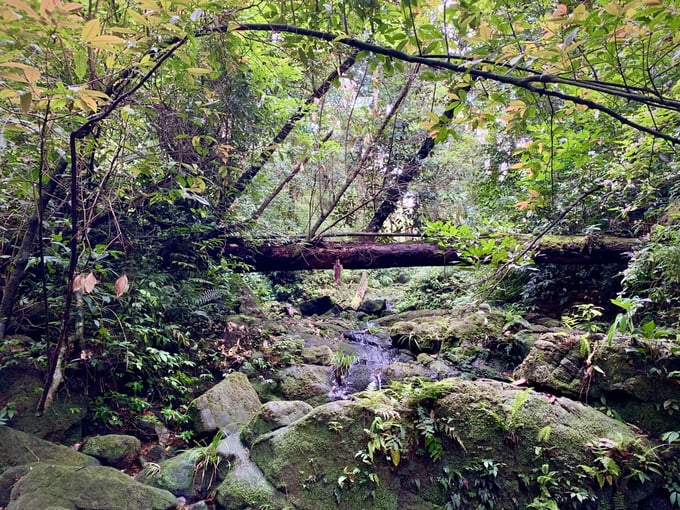
Inside the jungle in Vu Quang, there are countless spots that retain the wild scenery. Photo: Vu Quang National Park.
Aside from pride, many elderly people in Vu Quang hold more regrets when it comes to saola. In the 70s and 80s of the last century, when Vu Quang National Park was still the Vu Quang Forest Exploitation Site (1977-1993), catching saola was not that much of a rare thing.
The people at that time only thought of it as a “long-horned goat”, and considering the poor state of life in Nghe Tinh back then, no one cared about preservation. They normally trapped saola for meat. Saola would be caught every 2-3 days, and the people took the meat to fill their bellies while keeping the head and horns as decorations in the house.
Because of this, in 1992, when the domestic and foreign scientific teams of the Forest Investigation and Planning Institute, the Ministry of Forestry and the WWF organization came to implement the Indochina program, Vu Quang welcomed them with a surprise. The DNA sample test results were then recognized by world scientists as a new species.
The team also discovered the medium-sized deer, which is very closely related to the common Muntiacus muntjak, but has many different characteristics. This species was named giant muntjac (Megamuntiacus vuquangensis) after the local name of the land where it was discovered "Vu Quang".
From a remote area in Ha Tinh, Vu Quang suddenly became the focus of Vietnamese and international scientists. Many foreign scientific journals at that time devoted many articles about Vu Quang ox and Megamuntiacus vuquangensis. Later, Vu Quang ox was officially known as Pseudoryx ngotinhensis.
“Spending more time in the forest than at home”, that’s how Dinh Trong Hoang from the Department of Science, Technology & International Cooperation (Vu Quang National Park) summarizes his work. Each month, Hoang stays in the forest for about 27 days. The work of researchers like Hoang is quite complicated. In a nutshell, he goes to the forest, sets photo traps, and coordinates with forces such as border guards and police to prevent illegal hunting.
“I just thought about doing the job well in forest management and protection. I did not imagine having to go to the forest so much. But gradually it became a passion, regardless of steeps, erratic wind and rain, crossing streams and passes. It's hard to convey through words. Vu Quang is just beautiful, many places are so beautiful that it takes my breath away,” the 1993-born ranger said.
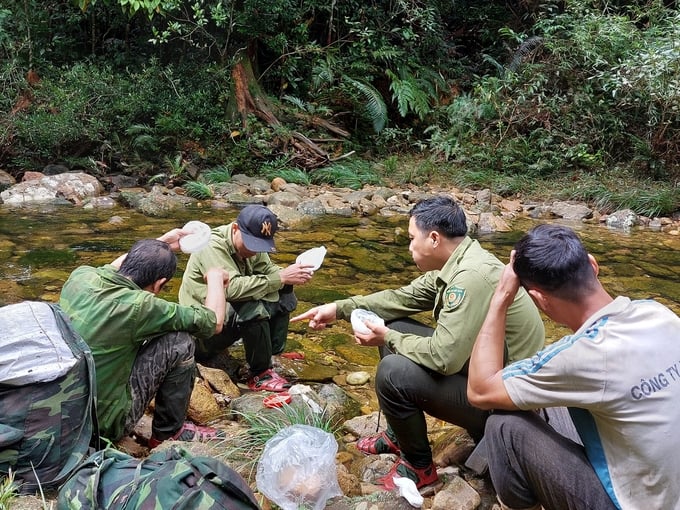
A hasty meal by the stream. Photo: Vu Quang National Park.
Although there are still difficulties in terms of regimes and equipment, he and many of the park staff have such a burning passion flowing in their blood. They want to prove the diversity of the park and then firmly protect it.
Although he has never seen saola with his own eyes, Hoang has met giant muntjac, striped rabbits, and other endemic animals of Vu Quang National Park, not to mention countless rare plant species. “Not seeing is different from not being able to. Good protection of the park's natural ecological environment is a condition for saola to come and ensure that other existing plant and animal species have the conditions to reproduce”.

Field tent, the temporary resting place of the forest patrol team. Photo: Vu Quang National Park.
The team’s hard work pays off. Some new species are discovered here such as Vu Quang dwarf frog (Vietnamophryne vuquangensis) and Danh Ky dragonfly. As for plants, there are Vu Quang yellow flower tea, Ha Tinh yellow flower tea, cha ran tuyen (Homalium glandulosum Tagane & V. H. Nguyen), Vu Quang sweet tea, Danh Ky chap, Vu Quang tan boi loi (Neolitsea vuquangensis); Vu Quang de (Lithocarpus vuquangensis). These results are published in prestigious international journals.
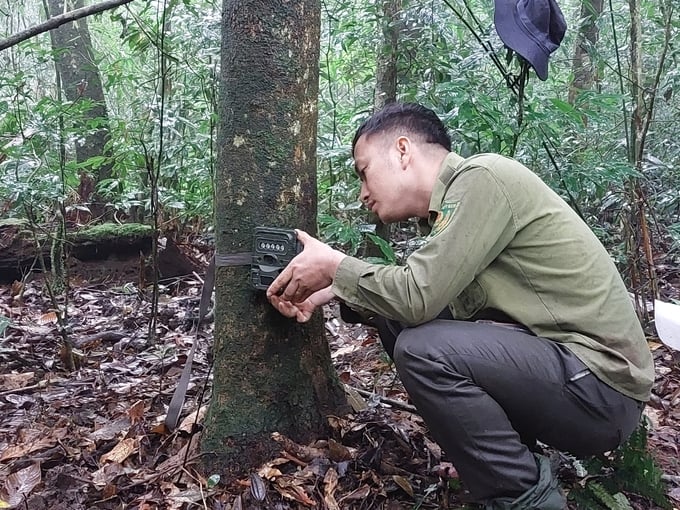
Mounting photo traps in Vu Quang forest. This is a thermal sensor camera. When warm-blooded animals pass by, it will auutomatically take pictures. Photo: Vu Quang National Park.
It is a challenge to gather enough words to describe the pristine and magnificent beauty of Vu Quang. The alluring green Ngan Sau River, the broad Ngan Trui lake, and the majestic Truong Son range surround the towns like a valley harboring thousands of trees and birds.
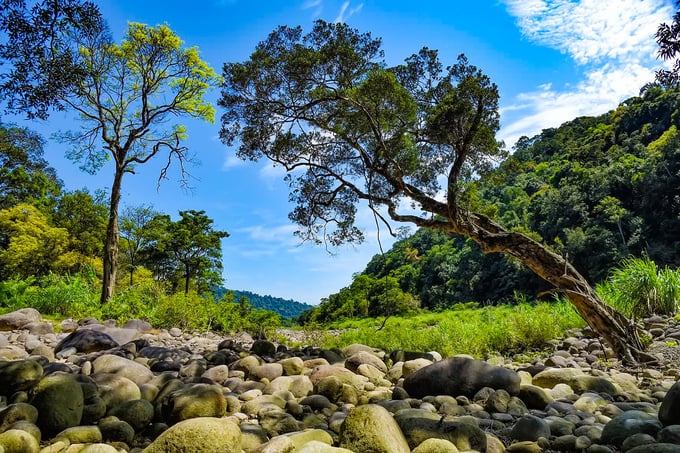
The beauty of the scenery in Vu Quang is straight out of a fairy tale. Photo: Vu Quang National Park.
Vu Quang National Park is favored by nature with countless interesting spots such as Rao Rong Ravine with emerald green water winding more than 20 km. Thang Day waterfall is more than 40 m high like a white silk strip falling in the middle of the forest. The concentration of a large number of migratory birds, water birds, aquatic animals, plus the clear blue lake bed, has created a magnificent, unspoiled landscape with potential for ecotourism development.
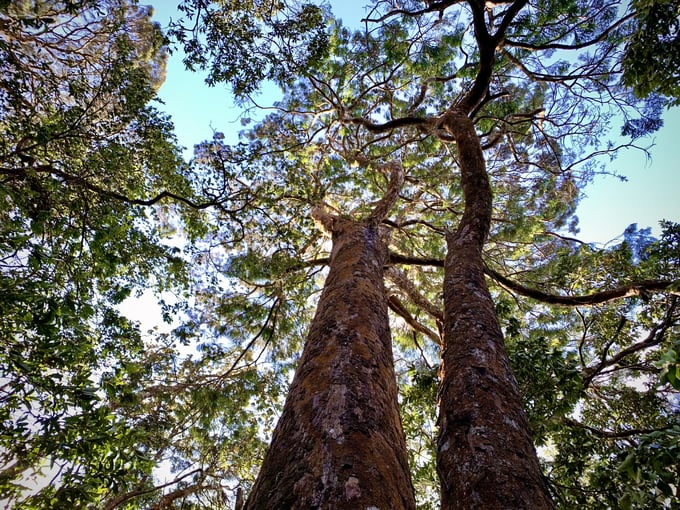
Scientists have confirmed that there are many rare plants in Vu Quang. There is even a record of an ancient Fokienia forest up to approximately a thousand years old. Photo: Vu Quang National Park.
When the park was newly established, a leader of Ha Tinh called it "the most hot spot in Indochina", because illegal hunting took place every day. Any animal could be brought to the drinking table. Pangolins, chamois, birds, snakes, nothing was missing.
The age clouded with ignorance is over. Vu Quang people now consider wild animals as friends to protect, not food. The awareness of nature protection has been raised, many people actively bring wild animals raised from childhood to hand over to the park. Most are monkeys, which are bought and raised by people in Vu Quang and many places in Ha Tinh since childhood as pets.
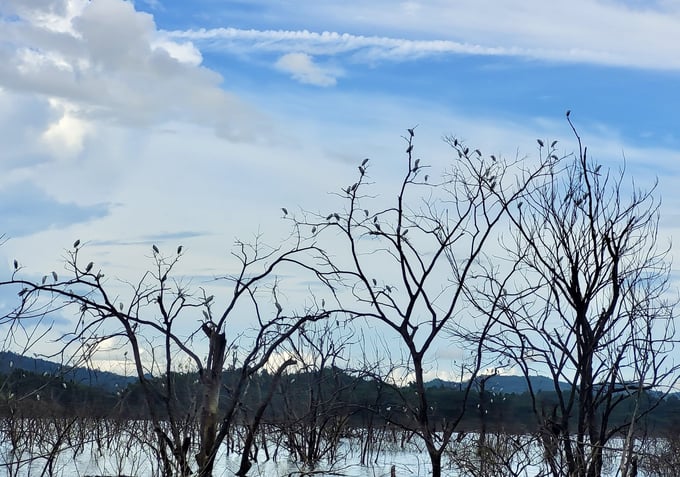
A corner of Ngan Truoi lake with many species that hunt birds choose to reside. Photo: Vu Quang National Park.
With an area of more than 57,000 ha with a flooded area of more than 4,000 ha, forming 32 independent oases, and dense forest, Vu Quang becomes the promised land of many wild animals and plants.
In the past few years, hundreds of rare and endangered animals have been selected by people and authorities in Vu Quang National Park to be cared for and monitored before being released back into the natural environment: Pig-tailed macaques (Macaca leonina); Stump-tailed macaque (Macaca arctoides); Assamese macaque (Macaca assamensis); northern white-cheeked gibbon (Nomascus leucogenys); rhesus monkey (Macaca mulatta); pygmy slow loris (Nycticebus pygmaeus); reticulated python (Python reticulatus); masked palm civet (Paguma larvata); Asian palm civet (Paradoxurus hermaphroditus), Indochinese box turtle (Cuora galbinifrons); Impressed tortoise (Manouria impressa).
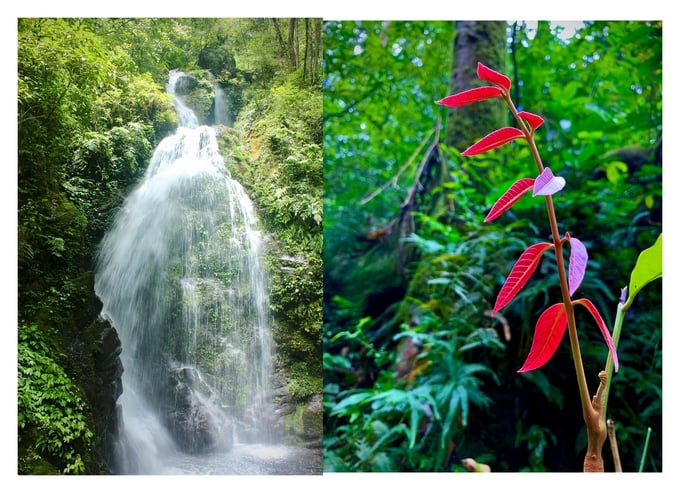
Vu Quang becomes the promised land of many wild animals and plants. Photo: Vu Quang National Park.
Translated by Samuel Pham
![Turning wind and rain into action: [4] Bringing climate bulletins to remote and isolated areas](https://t.ex-cdn.com/nongnghiepmoitruong.vn/608w/files/linhnhp/2025/06/14/1152-z6704423696987_15fd32ffc26d590d204d520c9dac6786-nongnghiep-151141.jpg)
(VAN) The Vietnam Agriculture and Nature Newspaper interviewed Mr. Vu Thai Truong, Acting Head of Climate Change and Environment at UNDP Vietnam, to gain deeper insight into how climate bulletins are delivered to farmers.
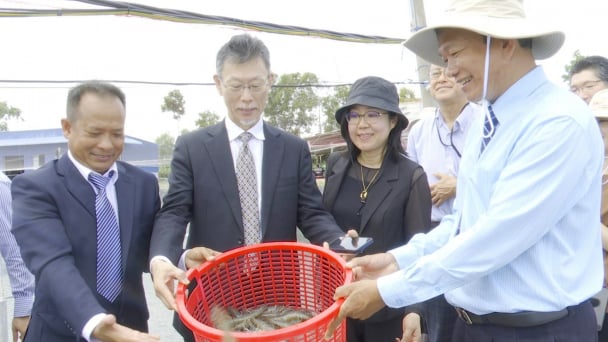
(VAN) In Tien Giang, a high-tech shrimp farm has developed a distinctive energy-saving farming model that has yielded promising results.
![Turning wind and rain into action: [3] 300.000 farmers benefit from agro-climatic bulletins](https://t.ex-cdn.com/nongnghiepmoitruong.vn/608w/files/news/2025/06/12/e5a48259d6a262fc3bb3-nongnghiep-125122.jpg)
(VAN) The agro-climatic bulletin has become a valuable tool for farmers in the Mekong Delta. After more than five years of implementation, the initiative is gradually being expanded nationwide.
![Turning wind and rain into action: [2] Providing forecasts to the people](https://t.ex-cdn.com/nongnghiepmoitruong.vn/608w/files/news/2025/06/12/e5a48259d6a262fc3bb3-nongnghiep-103927.jpg)
(VAN) In addition to improving the quality of hydrometeorological forecasts, putting forecast bulletins into practical use is crucial for production and disaster prevention.
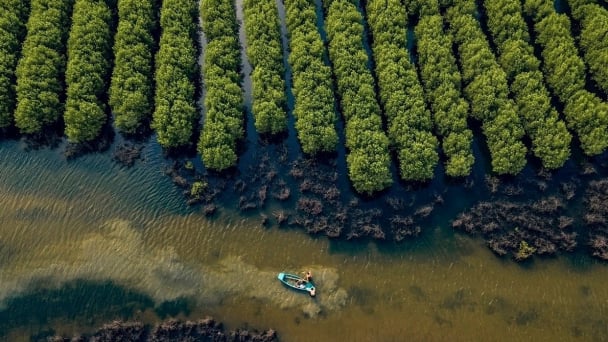
(VAN) Blue carbon is receiving attention for its rapid absorption capacity and vast potential. It represents a promising nature-based solution to respond to climate change.
/2025/06/11/3507-1-161904_583.jpg)
(VAN) Seagrass beds and coral reefs serve as 'cradles' that nurture life in the ocean depths, creating rich aquatic resources in Vietnamese waters.
![Turning wind and rain into action: [1] Forecasting for farmers](https://t.ex-cdn.com/nongnghiepmoitruong.vn/608w/files/news/2025/06/11/e5a48259d6a262fc3bb3-nongnghiep-111919.jpg)
(VAN) Weather is no longer just a matter of fate. Forecasts have now become an essential companion for farmers in every crop season.